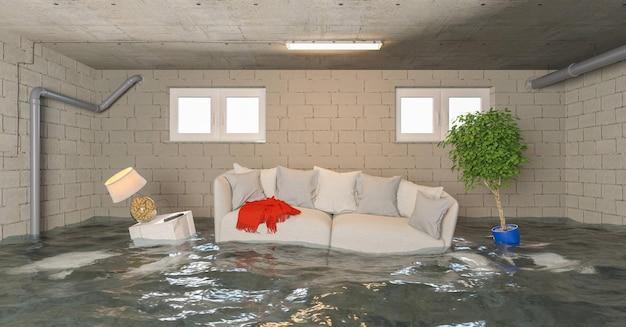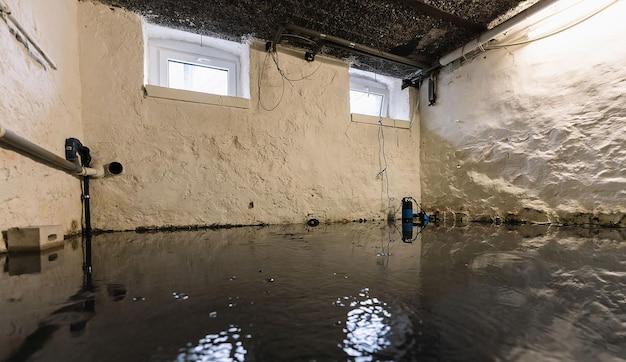Are you considering a walkout basement for your home, but worried about potential flood risks? Perhaps you already have a walkout basement and are experiencing problems with leaking or water damage. Don’t worry, you’re not alone. Many homeowners have concerns about the safety and practicality of walkout basements, especially when it comes to water-related issues.
In this comprehensive blog post, we aim to answer some of the most pressing questions about walkout basements and potential flooding risks. We’ll explore issues such as drainage problems, basement entry drains, and filling in walkout basements. We’ll also dive into the pros and cons of walkout basements, and offer some tips on how to prevent water from coming in through the door.
Ultimately, our goal is to provide you with the information you need to make an informed decision about whether a walkout basement is a good fit for your home. So whether you’re considering a conversion from a daylight basement or are simply curious about the safety of walkout basements, read on to learn more.
Do Walkout Basements Flood
If you’ve ever owned or seen a home with a walkout basement, you may wonder if these basement types are prone to flooding. The truth is, all basements are susceptible to flooding, and walkout basements are not exempted. In this subsection, we’ll discuss the factors that contribute to basement flooding, how to prevent it, and what to do if it occurs.
Factors Contributing to Walkout Basement Flooding
Several factors contribute to walkout basement flooding. First, the basement’s location, usually at or below ground level, makes it prone to water damage. Additionally, poor drainage, malfunctioning sump pumps, rainwater runoff, and clogged gutters could lead to water accumulation in the basement. If the foundation is weak, water could seep through cracks, crevices, and gaps around pipes, leading to flooding.
Preventing Walkout Basement Flooding
You can take several measures to prevent walkout basement flooding. Start by inspecting your foundation for any cracks, and repair them immediately. Ensure that your sump pump is working correctly, and clear its discharge line of any debris. Install gutters and downspouts and direct them away from the house to prevent rainwater accumulation. Additionally, evaluate your landscaping and slope the ground away from your home’s foundation.
What to Do If Your Walkout Basement Floods
If despite your preventive measures, your walkout basement floods, you should address it immediately. Start by cutting off the power supply in the affected area to avoid electrocution. Then, remove the water as soon as possible, and dry the affected area. If mold grows, clean it with a bleach solution. If the floodwater is severe, it may be necessary to seek professional help to avoid long-term damage.
In Conclusion
Walkout basements are not exempt from flooding, but preventive measures can minimize or prevent this from happening. If your walkout basement floods, take immediate action to avoid long-term damage. Remember to inspect your foundation regularly, keep your sump pump well-maintained, and manage your landscaping and gutters regularly. By doing this, you can significantly reduce the risk of basement flooding.
Do Walkout Basements Leak
Walkout basements have become popular in recent years, and they offer many advantages to homeowners. However, one common concern that many homeowners have is whether or not walkout basements leak. Here’s what you need to know.
Causes of Walkout Basement Leaks
Walkout basements can leak due to a variety of reasons, including:
Poor Drainage
Inadequate drainage can cause water to pool around the foundation of your home, leading to leaks or even flooding in your basement.
Cracks in the Foundation
Over time, the foundation of your home can develop cracks that allow water to seep in.
Landscaping
Hardscaping and poor landscaping choices can cause water to flow towards the home instead of away from it, leading to water damage in the walkout basement.
How to Prevent Walkout Basement Leaks
Preventing leaks in your walkout basement is possible by taking the following steps:
Landscaping
Taking steps to ensure that the soil around your home slopes away from the foundation can help prevent water from pooling around the home.
Waterproofing
Applying sealant to the foundation walls is one way of preventing moisture from penetrating the walls and causing damage.
Gutter Maintenance
Cleaning out your home’s gutters and extending downspouts away from the home is crucial to prevent water damage in the basement.
In addition to these preventive measures, it’s also important to regularly inspect your basement for any signs of water damage or leaks.
Walkout basements are a valuable addition to any home, and with proper maintenance and care, they can remain dry and free from leaks. However, it’s important to address any issues early on to prevent costly repairs down the line. By employing a few simple preventive measures and regularly inspecting your basement, you can enjoy all the benefits of a walkout basement without worrying about leaks or water damage.
Are Walkout Basements Safe
If you’re considering building or buying a home with a walkout basement, you may be wondering whether this type of basement is safe. After all, walkout basements are partially above ground level and often have direct access to the outdoors, creating potential safety hazards that you don’t face with a fully or partially underground basement. In this section, we’ll explore some of the safety factors to consider when evaluating whether a walkout basement is a safe option for your home.
Structural Stability
One of the most important safety considerations when it comes to walkout basements is structural stability. Because walkout basements are partially above ground level, they typically require additional structural support to ensure that the weight of the above-ground portion of the house doesn’t cause any damage or collapses. When evaluating a home with a walkout basement, make sure you have a professional home inspector examine the structural integrity of the foundation and the basement walls to ensure that the weight is appropriately supported.
Emergency Exits
Another safety factor to consider when evaluating a walkout basement is emergency exits. Because these basements have direct access to the outdoors, it’s important to ensure that there are adequate emergency exit options in case of a fire or other emergency. This can include windows that are large enough to escape from, and doors that are easy to open from the inside. You should also ensure that these exit options comply with local building codes and safety regulations.
Security
Security is also an important safety factor to consider when evaluating a walkout basement. Because these basements have direct access to the outdoors, they may be more vulnerable to break-ins or other security threats. Make sure that all doors and windows have appropriate locks and security features, and consider installing a security system to help protect your home. You should also ensure that your outdoor areas, such as patios or decks, are well-lit and free from potential hiding spots for intruders.
In conclusion, walkout basements can be a safe and functional option for your home, but it’s essential to evaluate them carefully for potential safety hazards. Ensure that the foundation and walls are structurally sound, that there are adequate emergency exits, and that the basement is secure. With these factors in mind, you can enjoy the benefits of a walkout basement without sacrificing safety.
Walkout Basements: A Popular Choice for Homeowners
Walkout basements are a popular choice for homeowners who want to maximize their living space. These are basements that have a door or window at ground level, allowing you to walk out into your yard rather than having to use stairs. They offer natural light, increase the value of your home, and provide extra living space.
The Benefits of Walkout Basements
Walkout basements have become more popular over the years, and for good reason. They offer several benefits, such as:
Natural Light
Whether it’s the cheerful sunshine or the sound of the raindrops, natural light can make a massive difference to the mood. This feature is what makes walkout basements stand out from other types of basements. With a door or window at the ground level, walkout basements receive a lot more natural light than traditional basements, which tend to be quite dark.
Extra Living Space
Walkout basements provide additional living space that can be used for a variety of purposes, such as a guest suite, a home office, or a playroom for the kids. They’re especially useful if you have a large family or frequently entertain guests.
Enhanced Aesthetics
Walkout basements can significantly enhance the look and feel of your home, especially if your yard is sloped or on a hillside. They blend seamlessly with your yard, making your home look more attractive, and can increase your property value.
Walkout basements can be a valuable addition to your home, providing additional living space, natural light, and increased property value. When it comes to finding the right type of basement for your home, consider a walkout basement. It’s no surprise that they’re becoming increasingly popular among homeowners.
Installing a Basement Entry Drain
Basement entry drains are designed to keep water away from your walkout basement. Before you install a basement entry drain, consider hiring a professional to ensure it’s done correctly. Here’s what you need to know:
Determine where to Install the Drain
The first step is to determine where to install the drain. Check the surrounding landscape and soil to decide where water will run. When installing an entry drain, you should consider placing it near the location where water would enter the basement.
Dig an Appropriate Trench
Dig a trench around the basement to place the drain pipe. The trench must be deep enough and wide enough to hold the drain pipe. The depth and width depend on your soil type and the amount of water you expect to handle.
Install the Entry Drain
Once you’ve dug the trench, place the entry drain into the trench. Make sure the pipe is sloping downwards towards the exit point. Cover the pipe with aggregate and fill the trench with soil.
Ensure Regular Maintenance
Regular maintenance of the entry drain is essential to ensure its longevity. Regularly check the drain for any debris or blockages that might hinder the flow of water. Consider hiring a professional to perform routine maintenance.
Installing a basement entry drain is an excellent way to keep water out of your walkout basement. The process can be difficult for beginners, so it’s essential to hire a professional to do the job properly. Proper installation and regular maintenance ensure that your entry drain will work effectively for years to come.
Walkout Basement Drainage Problems
Walkout basements are an excellent way to increase both living space and property value. However, they require careful maintenance because of the risk of flooding from inadequate drainage systems. This section will detail some of the most common walkout basement drainage problems.
Poorly Designed Drainage Systems
The primary reason for a flooded walkout basement is a drainage system that is either poorly installed, clogged, or nonexistent. Without proper drainage, any water around the home, including rainwater and snowmelt, will seep into the walkout basement. Proper drainage should include:
- Downspouts positioned away from the basement
- Sloped gutters to carry water away from the home
- Grading around the house to direct water away from the foundation
- French drains to redirect water from vulnerable areas
Concrete Cracks
Concrete cracks are also common and can contribute to flooding. These cracks in the foundation walls, walkout door thresholds, or floors allow water to seep into the basement. Regular inspection and repair of these cracks can prevent water penetration.
Landscaping Issues
Trees and shrubs close to the foundation can introduct moisture and clog footing drains. Additionally planting beds near the draining system may cause it to become overwhelmed and fail. Positioning gardens and other landscaping elements away from drainage system or directing water away from the area will solve the problem.
Poorly Installed Foundation Waterproofing
Another common issue that often leads to excessive moisture and flooding are inadequate or missing waterproofing measures. Although costly, basement waterproofing should be prioritized to avoid these complications. These measures include interior or exterior waterproofing, the installation of a sump pump system, and the addition of a vapor barrier.
A quick and thorough inspection of your walkout basement will identify any drainage problems and can save you unnecessary expenses later on. With proper maintenance, a walkout basement is an excellent addition to any home.
Converting a Daylight Basement to a Walkout: What You Need to Know
Daylight basements are great for increasing your home’s living space without committing to a full-fledged basement. But what if you want even more natural light and easy access to your outdoor living space? The answer is to convert your daylight basement to a walkout.
What Is a Walkout Basement
A walkout basement, also known as a daylight basement, allows you to step directly out of your basement into the yard. This makes it an attractive option for homeowners who want to enjoy their outdoor living space and also increase their home’s value.
Benefits of a Walkout Basement
Not only does a walkout basement provide the benefits of a traditional basement, but it also adds an extra level of convenience and accessibility to your outdoor living space. You can easily furnish your outdoor space and use it as an extension of your home.
Steps to Convert a Daylight Basement to a Walkout
Converting your daylight basement to a walkout requires a bit of planning and work. The steps involved include but are not limited to assessing your basement’s layout and design, creating an access door or window, installing a stairway and/or a deck, and weatherproofing.
Hiring a Professional
While you may be inclined to take on the project yourself, hiring a professional contractor ensures the job is done correctly and safely. Contractors have the expertise and experience to handle any hiccups that may arise during the conversion process.
Converting your daylight basement to a walkout is a great way to add value to your home and make it more attractive to potential buyers. With a little planning and the help of a professional, you can create a beautiful and convenient outdoor living space that you’ll enjoy for years to come.
Are Walkout Basements Less Likely to Flood
Walkout basements are a popular choice for homeowners who want to maximize their living space while taking advantage of their scenic surroundings. These types of basements have a separate entrance at ground level, which can be useful for accessing outdoor patios or backyards. But do walkout basements flood more easily than other types of basements? Let’s take a closer look.
Understanding Walkout Basements
Before we dive into the flood risk of walkout basements, it’s important to understand how they’re different from other types of basements. Walkout basements are built on a slope so that one side of the basement is partially or fully above ground level. This allows for natural light and an open feel, making them a popular choice for homeowners who want to create additional living space.
The Risk of Flooding
While walkout basements can offer many benefits, they can also be prone to flooding if they’re not properly constructed or maintained. Since walkout basements have an entrance at ground level, they’re more susceptible to water damage from heavy rainfall, melting snow, or other sources of moisture.
However, it’s important to note that not all walkout basements are the same. Some are built with proper drainage and waterproofing systems that can help to prevent flooding. Others may be more vulnerable due to their location or construction materials. Additionally, the flood risk can vary depending on the climate and weather patterns in the area.
Mitigating the Risk
If you’re considering a walkout basement for your home, there are steps you can take to minimize the risk of flooding. It’s important to work with a trusted contractor who has experience building and waterproofing walkout basements. They can ensure that the basement is constructed with proper drainage systems and waterproofing materials to prevent water damage.
You should also keep an eye out for any signs of water damage, such as mold or mildew growth, standing water, or musty odors. These could be signs of an underlying problem that needs to be addressed. Additionally, it’s important to maintain your walkout basement regularly by cleaning out gutters, fixing leaks, and making any necessary repairs.
In conclusion, while walkout basements can potentially be more prone to flooding than other types of basements, the risk can be mitigated with proper construction, maintenance, and upkeep. By taking the necessary steps to ensure the waterproofing and drainage systems are working effectively, you can enjoy all the benefits of having a walkout basement without the risk of water damage.
What Are the Disadvantages of a Walkout Basement
While walkout basements have numerous advantages, there are also some potential disadvantages that homeowners should consider before deciding to have one. Here are a few things to keep in mind:
Moisture and Flooding
One of the most significant disadvantages of a walkout basement is the increased risk of moisture and flooding. Because these basements are partially above ground, they’re more vulnerable to water infiltration than a fully buried basement. This can lead to issues with dampness, mold, and mildew, which can degrade indoor air quality and create health concerns.
Structural Complexity
Another potential disadvantage of a walkout basement is structural complexity. Because these basements are partially above ground, they require more reinforcing to maintain the integrity of the structure. Additionally, the design process for a walkout basement is more complex than a regular basement, which can increase construction costs.
Less Privacy
Walkout basements are often situated in the backyard, which means the windows and the entrance are visible to anyone in the backyard. This can compromise privacy and may be a concern for some homeowners.
Higher Cost
While walkout basements offer additional living space and natural light, they’re typically more expensive to build than a regular basement. This is because the construction process requires much more work than a regular basement, which can increase the cost significantly.
Impact on Home Value
Lastly, a walkout basement may not appeal to all buyers, which can impact the value of your home when you sell it. While some buyers might see it as an advantage, others may not appreciate the additional space and may be concerned about moisture or privacy issues.
Overall, a walkout basement can be a great addition to any home. However, it’s essential to consider the potential disadvantages as well as the advantages before deciding if it’s the right choice for you.
How to Prevent Water From Seeping Through Your Walkout Basement Door
A walkout basement can be an excellent addition to your home, offering additional space for storage or recreation. However, it can also pose unique challenges, especially when it comes to water infiltration. Water seeping into your walkout basement can not only cause significant damage to your property but can also be a health hazard for your family.
Below are some effective ways to prevent water from seeping through your walkout basement door:
1. Install a Drainage System
One of the most effective ways to prevent water from seeping through your walkout basement door is to install a proper drainage system. A drainage system is designed to redirect water away from the house’s foundation, preventing it from pooling around the basement door.
You can install a French drain around the walkout basement to direct water away from the house’s foundation. Alternatively, you can choose to install a dry well, which collects excess water and stores it until it slowly soaks into the surrounding soil.
2. Build a Barrier
Another way to prevent water from seeping through your walkout basement door is to build a barrier. You can construct a berm or a retaining wall around the perimeter of the walkout basement to keep excess water away.
A berm is essentially an elevated mound of soil that redirects water away from the house’s foundation. A retaining wall, on the other hand, is a structure made of concrete, stone, or brick that “retains” the soil and prevents water from seeping through.
3. Waterproof the Door
You can also prevent water infiltration by waterproofing your walkout basement door. There are several waterproofing products available, including sealants, waterproofing paint, and rubber membranes.
Ensure that proper waterproofing products are used for your door, and make sure that a professional installs them. This will help to ensure maximum efficiency.
4. Regular Maintenance
Regular maintenance is essential to prevent water from seeping into the walkout basement. Keep gutters and downspouts clean and free from debris. Ensure that the ground around the walkout basement slopes away from the foundation.
In conclusion, by taking the steps mentioned above, you can protect your basement from water seepage and avoid costly damage to your home. With some effort and a little investment, you can enjoy your walkout basement without any worry.



